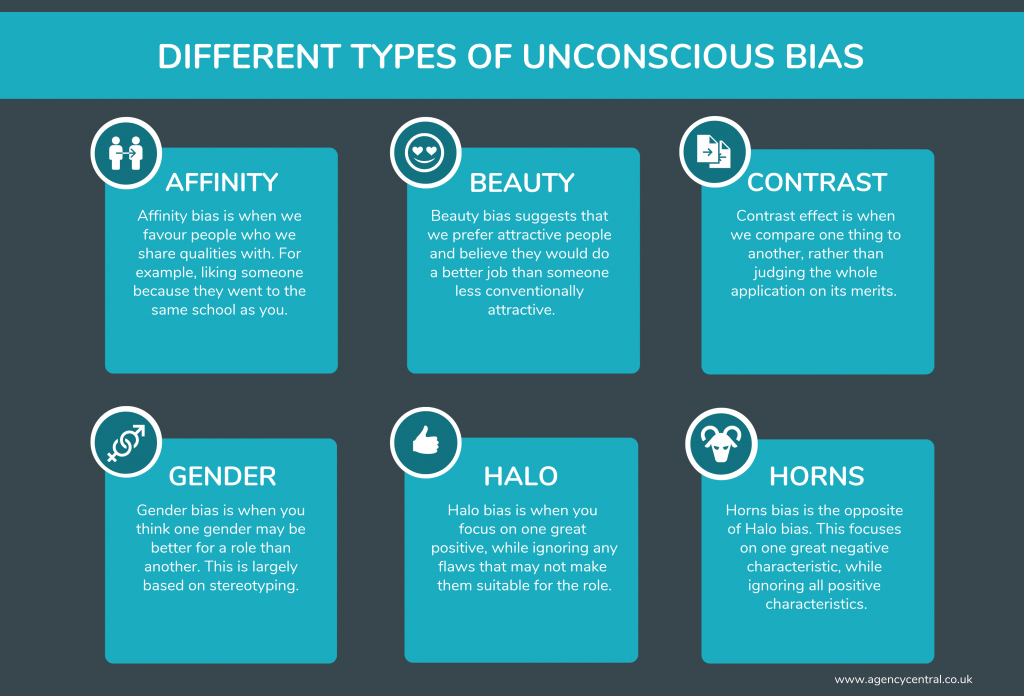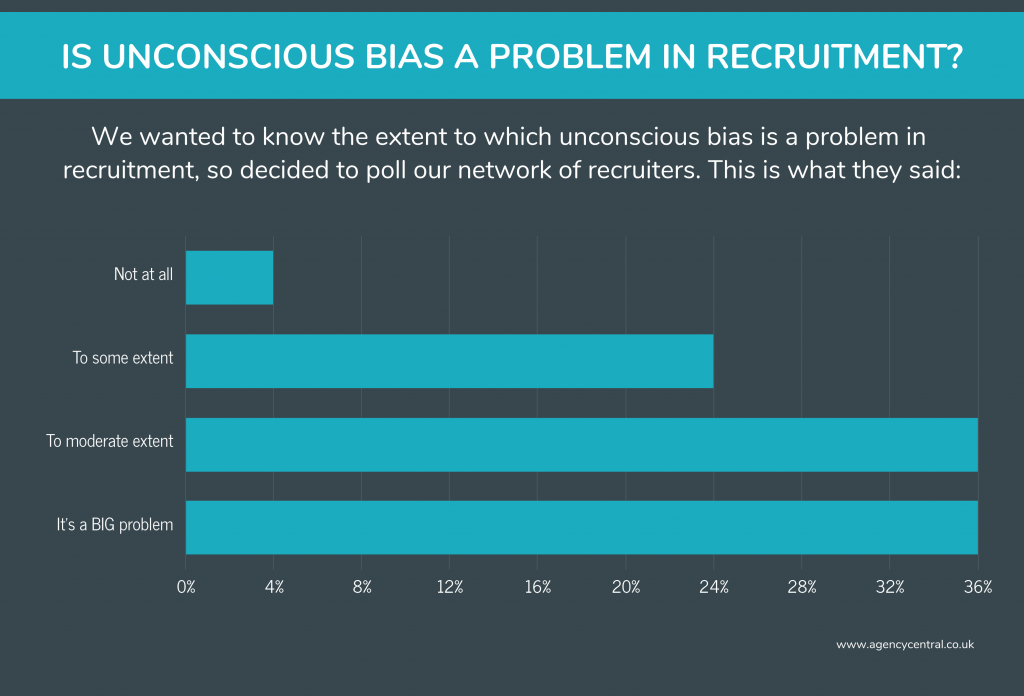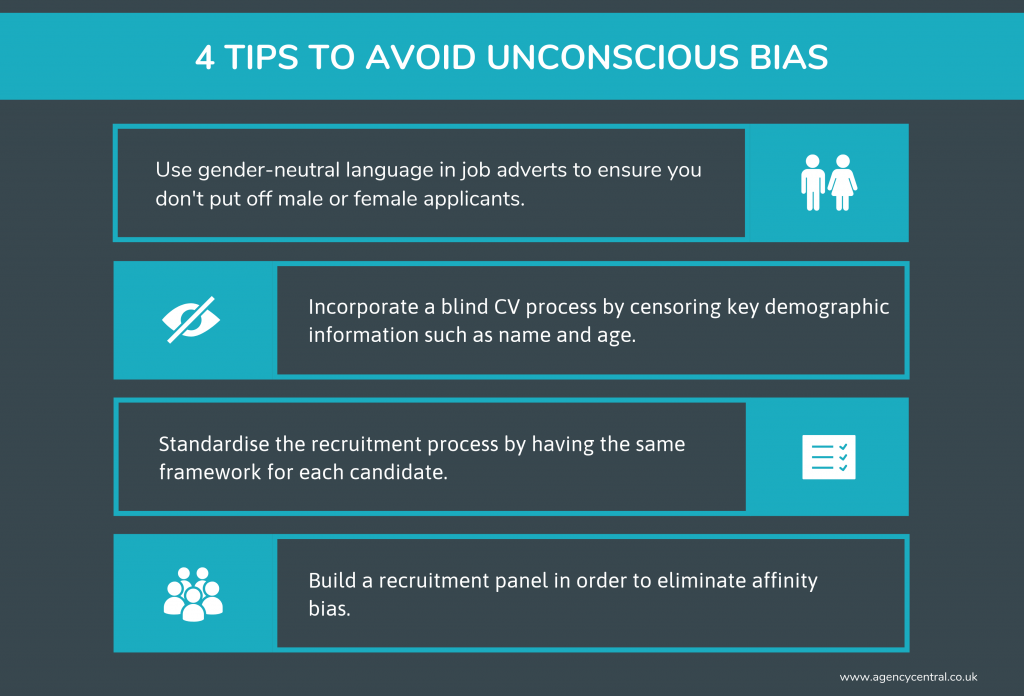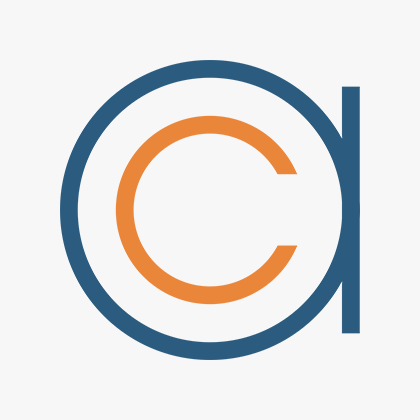Let me ask you a question: have you ever discriminated against a candidate?
While I have no doubt that you always try to conduct a fair hiring process, research suggests that all recruiters are susceptible to making decisions based on looks or background – and you might not even know you’re doing it.
Unconscious bias is widespread in recruitment and can be detrimental to agencies, employers and job applicants.
But what exactly is unconscious bias and is there anything recruiters can do to avoid it?
What is unconscious bias?
Unconscious bias, also known as implicit bias, occurs when we use our own experiences to make a quick judgement on an individual or group.
It’s essentially a form of stereotyping, whereby we unintentionally apply labels to different demographics and use them to inform our opinions.

There are many types of unconscious bias and each can sway your opinion on a candidate, although affinity bias is typically the most common in recruitment.
This suggests that you’ll favour a candidate who is ‘like you’ (because we’re all drawn to people who are similar to ourselves).
But why?
Research into unconscious bias suggests that this type of stereotyping comes from our ancestors’ predisposition to form relationships with groups similar to themselves – as a means to protect against ‘outsiders’.
While this defence mechanism is no longer necessary, we still carry around biases in order to make sense of the world around us and form instant decisions.
Is unconscious bias a problem in recruitment?
Due to the nature of hiring, the recruitment process is vulnerable to the trappings of unconscious bias.
We recently carried out a poll with our network of recruitment leaders and found that 96% of recruiters think that unconscious bias is a problem in the recruitment process.
Not only that, but more than a third of recruiters believe that unconscious bias is a ‘big problem’.
Only 4% think it has no impact on the recruitment process at all.

Jane Storer, Operations Director at ASC Connections, thinks that unconscious bias is a key contributor to bad hires and something that recruiters need to eliminate.
She said: “The impact that unconscious bias may have on the recruitment process should not be underestimated. It is often said that we like people more if we feel they are like us. But what if we are recruiting for a role that demands that the best person is nothing like us? If we don’t standardise our recruitment process, best case we end up with the right person in the wrong role and worst case, wrong person, wrong role”.
Extensive research into the topic suggests that unconscious bias may, indeed, be underestimated.
For instance, in 2015, CIPD produced a report into the role that behavioural science plays in recruitment and found that a whole range of factors can influence how an employer evaluates a candidate.
Some of the findings included:
- Recruiters are more likely to hire people who are like themselves.
- ‘Ethnic’ names get less response than ‘white’ names.
- Male interviewees are less successful than female interviewees.
- Factors such as time of day or temperature can affect how an interviewer feels about a candidate.
- Candidates may get asked different questions to justify biases.
Of course, unconscious bias isn’t always a problem; it can be a great time saver when CVs are piling up and deadlines are pressing.
However, it’s clear that stereotyping is having a notable impact on recruitment – but how exactly?
How unconscious bias affects the recruitment process
We might have established the presence of unconscious bias in recruitment, but what does this actually mean for the industry?
The Equality Act and ‘protected characteristics’
While unconscious bias may be innocent, it can see recruiters fall foul of discrimination and employment laws.
This is predominantly centred around the Equality Act 2010, which was introduced to minimise discrimination in regards to nine ‘protected characteristics’.
These protected characteristics are:
- Age
- Disability
- Gender reassignment
- Marriage & civil partnership
- Pregnancy & maternity
- Race
- Religion & belief
- Sex
- Sexual orientation
No matter how unintentional the bias is, if a candidate feels they have been discriminated against because of one of these characteristics, you could be breaching the law.
We recently carried out a poll with our network of recruitment leaders and found that 96% of recruiters think that unconscious bias is a problem in the recruitment process.
In fact, it is now illegal to ask questions about protected characteristics, whether at the application or interview stage (although there are very special exceptions).
85% of interviewers have asked illegal interview questions, with women more likely to be asked inappropriate questions than men.
The ‘wrong’ hire
As you begin to develop preferences over certain qualities, the size and diversity of your talent pool will naturally start to shrink.
This means three things:
- You’re missing out on excellent candidates.
- You’re risking making the wrong placement.
- You’re failing to help clients build a diverse workforce.
In a time when skill shortages are greatly impacting the industry, recruiters can’t afford to let talent fall through the net.
After all, your agency brand depends on the candidates you supply.
Anthony Jessop, Social Media Lead at Addition Solutions, believes that stereotyping is bad for recruiters and candidates – especially in regards to ethnicity:
“There might be an urgent role that needs filling and some recruiters will only look for certain ethnicities of people. This can slow the role down and result in a candidate not being placed due to unconscious bias. Many recruiters need to look past stereotypes and ethnicities and treat everyone the same. Unfortunately, this is not the case as many recruiters will never change, it would make the recruitment industry a lot fairer for candidates.”
If you’re consistently failing to place a diverse and quality selection of staff, then clients may start to look elsewhere.
All of this means that recruiters have to try harder to ensure that biases don’t creep into their process when screening candidates.
How can recruiters avoid unconscious bias?
Removing bias from the recruitment process isn’t easy, but there are a few things that agencies can do to help level the playing field for candidates.

We’ve come up with four simple steps that agencies can take to minimise unconscious bias and conduct a fairer hiring process.
Gender-neutral language
When writing a job ad or description, you might not think about the effects of your word choices – but think again.
Various studies have suggested that particular words and phrases can put off or exclude certain job applicants.
Gender-biased language denotes words that are thought to appeal more to either male or female applicants.
For example, ads with more masculine phrases (e.g. adventurous) tend to attract more male applicants – while more feminine phrases (e.g. enthusiastic) attract more female applicants.
Opting for neural wording could increase the number of applicants by 42%.
Blind hiring
While a CV might not hold much information regarding disability or sexual orientation, it turns out that we only need a name to make a judgement.
A startling example of this comes from a 2009 study which showed that job applicants with ‘white’ sounding names were 74% more likely to receive a positive response than those with ‘ethnic’ sounding names.
Blind hiring is an approach that aims to anonymise candidates by censoring certain demographic information.
Censorship can range from name and date of birth, through to schools and universities.
By doing this, recruiters are judging a candidate solely on their merits and increasing the diversity of their shortlist as a result.
Standardise interviews
One of the best ways to reduce bias is to standardise as much of the recruitment process as possible.
The interview stage is arguably the biggest priority when it comes to standardisation, as the majority (but not all) of bias occurs after meeting the candidate face-to-face.
Of course, unconscious bias isn’t always a problem; it can be a great time saver when CVs are piling up and deadlines are pressing.
A 2000 study, by the University of Toledo, showed that opinions are formed in the first 10 seconds of a job interview – and the rest of the interview is spent trying to back up those opinions.
The trick to avoiding this is to have the same list of questions for each interviewee. This not only ensures that conversation stays strictly focused on the job role, but it also gives candidates an equal opportunity to really sell themselves on their credentials.
Having a concrete interview framework should minimise the impact of bias – no matter who is doing the interviewing.
Diverse recruitment panel
Unconscious bias suggests that we’re likely to recruit people who are similar to ourselves, or at least coincide with some kind of internal moral code.
So, how do you eliminate this?
Answer: increase the number (and type) of people involved in the process.
For instance, if only one person is responsible for interviews, the candidate will have to hope that they aren’t negatively impacted by the biases of that individual. Having a group of people, on the other hand, will mean that biases are likely to be cancelled out – leading to a fairer judging process.
Applied, a recruitment platform, found that hiring accuracy improves when three people are involved in the decision-making process. Their study showed that this scenario caused wrong hire rates to fall to 15%.
Having a panel of different people, rather than just an individual, can make the applicant feel that they’re being assessed fairly – especially if they come represent a minority group.
To end
Unconscious bias is undoubtedly having an effect on the recruitment industry.
This probably isn’t intentional, but recruiters, employers and candidates all stand to miss out if this type of stereotyping continues to go unchecked.
As Emily Fuller, Marketing Executive at Busy Bee Recruitment, says: “You will need to be aware of what unconscious bias is and take your time when making decisions. Always focus on the positive behaviour of the individual. You can even justify why you have hired someone by producing documents on your decision making.”
Eliminating bias from the recruitment process should, therefore, be a top priority for recruitment agencies, in order to ensure that they continue to supply quality candidates and support diverse workforces.



